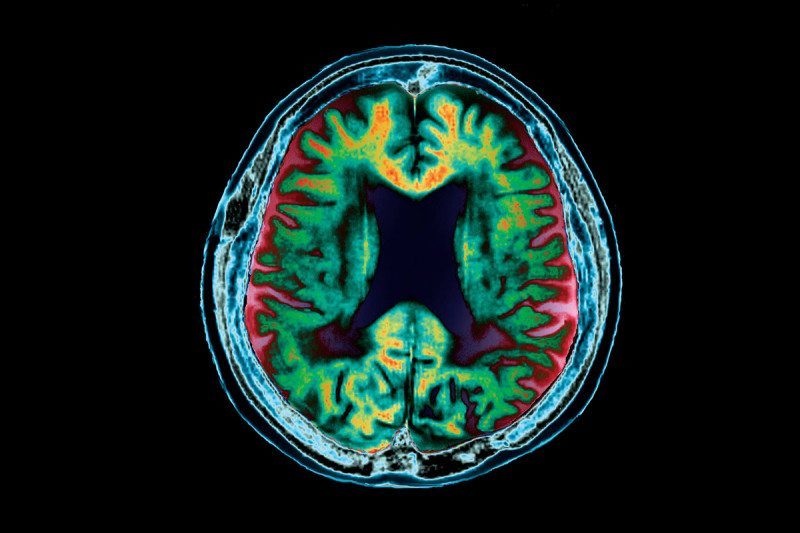In the United States, approximately 6 million American adults have Alzheimer's disease or mild cognitive impairment. The estimate forecasts that these numbers will more than double to 15 million by 2060. These estimates include people with biomarkers or other evidence of possible preclinical Alzheimer's disease, but who do not have impairment or Alzheimer's dementia. People with such signs of preclinical disease are at increased risk to develop Alzheimer's dementia.
We are led to believe that Alzheimer's disease (AD) has no cure or there is no possibility of halting the cognitive decline. At best, mainstream treatment just slows down the progression of the disease. As a rule, the person deteriorates beyond recognition throughout the remaining years of their life while hopeless caregivers get burned out. For this reason, I was pleasantly surprised when Mark Sisson wrote recently about a study which was published in Aging (2014) by Dale E. Bredesen. The study revealed incredible results that mainstream media outlets failed to cover.
The 10 participants of the study started from very serious deficits including memory impairment from Alzheimer's, amnesiac cognitive impairment, and/or subjective cognitive decline. After following a comprehensive and personalized therapeutic program based on the underlying pathogenesis of Alzheimer's disease, nine of the ten patients showed subjective or objective improvements in cognitive function and performance within 3-6 months. One failure was a person with late-stage Alzheimer's disease. Of the six patients who'd had to stop working due to their cognitive decline, all six were able to return to work. In a 2.5 year followup, the patients had sustained and even improved on their results. Not bad at all considering how mainstream protocols have little or nothing to offer to AD patients.
Dale E. Bredesen even confirmed in a study published in 2016 that the program worked in subjects with the genetic variant that increases the risk of Alzheimer's:
Here we report the results from quantitative MRI and neuropsychological testing in ten patients with cognitive decline, nine ApoE4+ (five homozygous and four heterozygous) and one ApoE4−, who were treated with the MEND protocol for 5-24 months. The magnitude of the improvement is unprecedented, providing additional objective evidence that this programmatic approach to cognitive decline is highly effective.Let's analyze what each subject did in the study and why it worked to reverse cognitive decline.
Eliminate all simple carbs and follow a low-glycemic, low-grain (especially refined grains) diet meant to reduce hyperinsulinemia
Insulin is the key that fits in the lock of the body's cells - it opens the doors for the sugar to get into the cells (and out of the bloodstream) in order to be burned. This process is referred to as glucose uptake.
In AD there is a fuel shortage in the brain - a reduction in the rate of glucose metabolized by the brain. In some, the reduction has been found to be 45 percent and is always localized to areas of the brain involved with learning and memory. There is a glucose-uptake impairment related to insulin resistance. In fact, AD is also known as "type 3 diabetes" since insulin resistance or a deficiency of working insulin in the brain are responsible for cognitive impairment and AD.
A marker of AD is the presence of amyloid-beta (Aβ) plaques, a build up of protein material which prevents neurons from working properly. To keep the brain clear you need a certain enzyme to break down these proteins. But your brain also uses the same enzyme to clear out insulin. In fact, it's called "insulin-degrading enzyme" or IDE. If you have insulin resistance, IDE is too busy clearing out insulin and has no time to break down amyloid-beta.
Ketosis is a state in which the body is burning ketones as its main source of fuel. Ketones are produced when the body starts using fat instead of carbohydrates for its main source of energy. Some fats are converted to ketone bodies to be burned preferentially by tissues like the brain and nervous system (which can't burn fat) while other tissues burn the fat directly.
Ketones as another source of fuel for the brain are only produced when insulin levels are low, such as when a person is on a low carbohydrate diet or fasting. Research has found that the brains of people with AD are capable of taking up ketones, benefiting cognitively.
Observe a 12-hour eating window and 12-hour fast each day, including at least three hours before bed
Intermittent fasting is about timing your meals to allow for regular periods of fasting, going without food for approximately 12 to 16 hours. It improves your metabolic health, making it a powerful tool for weight loss, and it has been shown to be just as effective as caloric-restricted diets for lowering your insulin levels. Fasting can raise blood levels of norepinephrine and human growth hormone and these can help you burn fat more easily, while preserving muscle mass.
Fasting also improves your brain function by increasing Brain-Derived NeuroTrophic Factor (BDNF) which lead to healthier neurons and better communication processes between these neurons.
Stress reduction (yoga, meditation, whatever works for the individual)
I highly recommend Éiriú Eolas (EE for short) - a program of breathing techniques which grew out of research conducted by the Quantum Future Group. Central to this program is stimulation of the vagus nerve, which activates the calm-inducing parasympathetic system - a powerful anti-inflammatory system in our bodies.
The combination of specific rhythms for voluntary breath control, conscious inhalation, retention and exhalation, in conjunction with meditation and 'belly-breathing' with correct use of the diaphragm, helps to increase levels of the anti-stress hormones GABA (our natural Valium), melatonin (our pineal gland hormone), and serotonin (our 'happy mood' brain chemical), whereas levels of the stress hormones cortisol and norepinephrine are decreased.
The Éiriú Eolas program uses what is called 'Pipe Breathing' as the key to instant stress reduction and control. Pipe Breathing stimulates the vagus nerve, the heart of the parasympathetic nervous system - the body's own 'anti-stress system'. The vagus nerve is your calming and relaxing nerve which goes from your brain down to your abdomen, dividing into multiple branches that reach your throat, your heart, and all your viscera. It is also called 'the wanderer', as it wanders throughout your body. When you take deep breaths in specific rhythm sets and meditate with Éiriu Eolas, the nerve is activated and it releases acetylcholine, which reduces the production of inflammatory molecules like cytokines that are linked to every known disease. For instance, brain inflammation is linked to every known mood, behavior, attention, memory, or degenerative disease.
The vagus nerve enhances neurogenesis (the creation of brain tissue) by increasing BDNF output - the "super-fertilizer" of brain cells. It helps repair brain tissue, but also helps with tissue regeneration throughout your body. BDNF plays an important role in neuronal plasticity, which is essential for learning, thinking and higher levels of brain function. Practicing Éiriú Eolas will therefore kick-start or improve neurogenesis and neuroplasticity, processes that are essential for maintenance of brain functions as we age, but also for recovery from trauma, emotional adaptation, and learning.
You can get a copy of the program at eebreathe.com, but you can also find an online version there where you can learn the techniques.
Get 8 hours of sleep a night (with melatonin if required)
Melatonin is a hormone made in the pineal gland which regulates the circadian rhythm. When the retina in the eyes stop sensing as much blue wavelength light, the suprachiasmatic nucleus - a region in the brain - senses this and induces the pineal gland to begin making melatonin. For more information, don't miss this SOTT focus on the subject: Is Artificial Light at Night Making You and Your Kids Fat & Sick?
Do 30-60 minutes of exercise 4-6 days per week
By exercising our muscles, we have the potential to not only reverse aging and brain-related diseases such as dementia which are characterized by mitochondrial dysfunction (a failure in the powerhouse of the cells), but as it happens, mitochondrial dysfunction is the final step in ALL diseases. In fact, by making new mitochondria, there is a remodeling of entire networks of mitochondria. New mitochondria merge with old ones, leading to elimination of damaged or dysfunctional mitochondria.
Get regular brain stimulation (exercises, games, crosswords)
Enhancing prefrontal cortex functioning through exercises to stimulate the brain, helps us regulate our emotions and think about our thinking. This brain region helps us focus our attention and plan complex actions.
Supplement to optimize homocysteine, vitamin B12, CRP levels
Homocysteine is an amino acid that is linked with cardiovascular disease and stroke. Low levels of B6, B12 and folic acid can cause raised levels of homocysteine. Measuring homocysteine levels is sometimes used as a proxy for B12 status. Tests which indicate low B12 status (e.g. raised homocysteine levels) are associated with lower cognitive function tests scores and smaller brain volume.
Inflammation in the body is common to many diseases. Inflammatory markers such as C-reactive protein (CRP) in middle-aged adults may be a more reliable predictor of longevity than any other test.
Take vitamin D and vitamin K2
Vitamin D insufficiency among the elderly is highly correlated with accelerated cognitive decline and impaired performance, particularly memory loss associated with Alzheimer's disease and dementia. Individuals with low vitamin D decline at a rate three times faster than those with adequate vitamin D levels.
Vitamin D metabolism is dependent on vitamin K, and vitamin D toxicity is actually caused by vitamin K deficiency.
Improve gut health (prebiotics and probiotics)
Good bacteria in the gut is critical to many human physiological factors such as immune function, nutrient processing, and in the function of the central nervous system.
Eat antioxidant-rich foods and spices (blueberries, turmeric)
In producing energy, your body also ages from the damaging aspects of pro-oxidants or free radicals that are generated. Some free radicals are good and your body requires them to regulate cellular function, but problems develop when there is excessive free radical production as in the case of most chronic illnesses (e.g. neurodegenerative diseases).
Optimize hormone balance (thyroid panel, cortisol, pregnenolone, progesterone, estrogen, testosterone)
These hormones have their role in excess weight, lack of energy, aging, and illness. Hormone imbalances can cause metabolic problems and lead to non-degenerative forms of dementia. Balancing your hormones can cure underlying health issues and result in restored sleep, greater energy, improved mood, easy weight loss, increased productivity, and many more benefits. For more information, check out Dr. Sara Gottfried's The Hormone Cure.
Obtain adequate DHA to support synaptic health (fish oil, fish)
Yves Sauve and his team at the University of Alberta discovered that lab models fed a high-DHA diet had 30 per cent higher levels of DHA in the memory section of the brain, known as the hippocampus, when compared to animal models on a regular, healthy diet.
What we discovered is that memory cells in the hippocampus could communicate better with each other and better relay messages when DHA levels in that region of the brain were higher. This could explain why memory improves on a high-DHA diet.When a diet is supplemented with DHA, that additional stores of the omega-3 fatty acid are deposited in the brain. Supplementing your diet with DHA, such as increasing fish intake or taking supplements, could prevent declining DHA levels in the brain as we age.
Omega 3 supplements such as fish oil have fallen out of favor in some circles because they get easily damaged (oxidized) with the exposure of oxygen. However, there are manufacturers who utilize a nitrogen environment to eliminate the oxygen exposure during the fish oil processing, thereby maintaining the integrity of these vulnerable oils. When supplement quality cannot be guaranteed, these fats are best consumed when coming from fresh food sources (i.e. fish oil from fresh fish sources).
Optimize mitochondrial function (CoQ10, zinc, selenium, other nutrients)
There are several co-factors needed for mitochondrial enzymes to function properly, including:
- CoQ10 or ubiquinol (the reduced form)
- L-Carnitine, which shuttles fatty acids to the mitochondria
- D-ribose, which is raw material for ATP molecule
- Magnesium
- Omega-3 fatty acids
- All B vitamins, including riboflavin, thiamine, and B6
- Alpha-lipoic acid (ALA)
Medium Chain Triglycerides (MCTs), found in coconut oil, boost cognitive function in AD patients - and just after a single 40 ml dose!
The researchers observed a significant increase in blood plasma levels of ketone bodies (beta-hydroxybutyrate) after only 90 minutes of treatment.
MCTs are easy to absorb and utilize. They are preferentially metabolized by the liver, and when provided in large enough quantities, they enhance ketone bodies production.
Photobiomodulation
Although not part of the original study, I'm including it here due to its amazing results in AD patients.
Photobiomodulation is a term referring to light's ability to modulate key biological processes at a cellular or genetic level. Light therapy, using red and near-infra-red light, has strong neuroprotective effects.
Dementia patients with serious cognitive deficits experienced a sharp improvement after just 12 weeks with the VieLight Neuro, an LED headset that shines pulsed near-infrared light on five targeted areas of the brain.
"These are people who haven't been able to speak in connected sentences for weeks or months who suddenly start having a conversation, speaking in full sentences, understanding and replying."For more information about the devices that people are using, including homemade ones, see Let there be light - Photobiomodulation.
"People who had to be fed by caregivers can suddenly pick up a knife and fork and start eating their own meals. Remarkable changes."
See also:
- The Alzheimer's antidote: using a low-carb, high-fat diet to fight Alzheimer's disease, memory loss, and cognitive decline
- Caffeine May Prevent and Help Reverse Alzheimer's Disease
- Nicotine helps Alzheimer's and Parkinson's Patients
- Iron in the brain boosts Alzheimer's risk
- These popular drinks consumed by 50% of people are linked to dementia
- Learning a new language expands the brain
- Sense of smell: The strangest early sign of dementia






Reader Comments